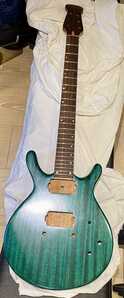Only concern now is that the bridge is a very tight fit in the mount holes, at least it is in the test ones, I meant to address that before I applied the finish but didn’t stupidly. Just hoping enlarging them doesn’t cause an issue!
@tej I had the same problem so I ended up using a slightly bigger drill bit to make the holes wider. I had to be very careful though, it was a little scary.
You could try and use a reamer, it would be less scary.
https://www.stewmac.com/luthier-tools-and-supplies/types-of-tools/reamers/5th-string-peghole-reamer/
Make guitars, not war 🌍✌️🎸
t was a little scary.
@boo I’m not putting a reamer anywhere near this build, bad experiences with them, if it comes to it I’ll make some tedious sanding tool and do it very carefully. I’ve some scrap to experiment on but I want to try to press the mounts in first with a (fill in some kind of homemade press here) as I’m pretty sure a hammer would be bad in so many ways! I’d it were basswood this wouldn’t be an issue but there is just no give in the mahogany!
…on an elaborate journey to turn trees into music.
I’m not putting a reamer anywhere near this build, bad experiences with them, if it comes to it I’ll make some tedious sanding tool and do it very carefully. I’ve some scrap to experiment on but I want to try to press the mounts in first with a (fill in some kind of homemade press here) as I’m pretty sure a hammer would be bad in so many ways! I’d it were basswood this wouldn’t be an issue but there is just no give in the mahogany!
@tej Fair enough. Mine was a mahogany body too and I used a slightly bigger drill bit to make the hole bigger and I tapped the posts in with a hammer (with a block of wood to dampen the blow, obviously).
Make guitars, not war 🌍✌️🎸
Only concern now is that the bridge is a very tight fit in the mount holes,
I hadn't masked off the bridge post holes when I lacquer my current build, so the holes have shrunk with all the lacquer that has dribbled in there. I used a cylindrical grinding stone on my dremel to clear them out with no damage to the finish.
I hadn't masked off the bridge post holes when I lacquer my current build
@robin ok, so I don’t do that either but I like the solution. What I’m thinking now is to do that to get the built up finish off and then colour the hole with soft graphite pencil lead and go over again until I’m back to wood, I think I only need to remove 0.1/0.2mm to give a tight but not damaging fit so one or two goes like that should do the job. Obviously one for the test piece first!
…on an elaborate journey to turn trees into music.
What I’m thinking now is to do that to get the built up finish off and then colour the hole with soft graphite pencil lead and go over again until I’m back to wood, I think I only need to remove 0.1/0.2mm to give a tight but not damaging fit
I cleared it out gradually until the plain part of the bridge post fitted in, but the splined part was still an interference.
with regard to masking the holes, I meant I didn’t do that, not that I don’t intentionally! That said do you know how you would go about this?
Short answer to this one is "no". I dont know what to put in there that wouldn't damage the finish taking it out.
…on an elaborate journey to turn trees into music.
Its possible to clean out the finish build up from post holes by running a sharp knife carefully round the inside. I know this sounds scary but the knife will take paint off without damaging the wood. It’s best to do it when it’s touch dry but not fully hardened as the paint will still be soft.
Some people call me a tool, others are less complimentary. Tools being useful things.
@tej For stuff like that, I’ve used a round file before. I use a really fine, thin, round file (a chainsaw sharpening file). Be careful just to push the file down into the hole and along the top edge to remove the paint. Put the file on a slight angle, just to remove the paint, there is no need to file the entire side of the hole. You are basically just putting a bevel around the rim of the holes (insert your own joke 🤣).
Make guitars, not war 🌍✌️🎸
One thing I would advise though is that you mask up the neck pocket at least,
@boo yeah I figured that a few coats in, masked it up and then started removing it between coats as it was building up a ridge at the edge. Indeed I’ve very much ignored the pickup cavities 🙂
…on an elaborate journey to turn trees into music.
clean out the finish build up from post holes by running a sharp knife carefully round the inside
@rocknroller912 thanks for the idea, i think the initial layers will be cured hard by now, I can test gently to see though.
…on an elaborate journey to turn trees into music.
I’ve used a round file before. I use a really fine, thin, round file
@boo I’ll have to look at the type of file you’re talking about, I have a half round mini file that might to, between that, @rocknroller912 suggestion and the more industrial dremmel approach from @robin I should be all good 🙂
…on an elaborate journey to turn trees into music.
Finally after finishing, having to sand back and re-apply the finish I have the neck in. Now, one of us, let’s say me, seems to have left a thin coat of glue residue where the heal of the neck joins the body. Hard to see from the pictures. Any suggestions on how best to clean this up? Current plan is to use 0000 wire wool to rub it down and then mask the neck off and apply another coat of finish to the body. If anyone has a better plan that doesn’t involve more finish I’d love to hear it please!?
i think there may be an issue with the neck not being 100% located as the height at the bridge dropped by 0.5mm, still gives room for the bridge without forcing a high action though so given it feel very solid I don’t think this is an issue. Is it was I’ve no idea how I’d go about separating the neck from the body anyway, not sure it’d be possible without destruction and I’m not keen to ever need to find out 🙂
Anyway, it’s starting to look more like a guitar now so that’s nice 😊
…on an elaborate journey to turn trees into music.
@Tej Wow man really nice result ! I really dig the color as well.
Regarding the neck position, can it be that it not only is seated a bit lower, but also that it moved back a little bit? that might explain why it is also a bit lower then expected. If that is the case, you probably have to check the scale length and the location of your bridge post holes as well. It does not look like much, so it might be nothing to worry about, but I'd check that as well. Height is probably no issue ( if too far off, you can always route a pocket to lower the bridge)
@koendb thanks 🙏 I checked around the join, there’s a gap (😔) on one corner where I’ve not fully seated it in the pocket on one side, I’d need a feeler gauge to measure it so it’s small. I checked the scale length too as you suggested and that’s fine.All things considered I’m not going to worry about it, I’m wondering if I just had one clamp off centre and too tight. I’ll be more careful next time!
…on an elaborate journey to turn trees into music.
Thats looking really good, the depth to that green is great. Try scraping the glue residue with a blade, I think you could be more accurate in what you're removing that with wire wool. I wouldn't worry about the gap at the neck join, it'll be strong enough. I had a little gap on one side and filled it with sand'n'seal mixed with stain.
@robin thanks for the feedback! Unfortunately the glue is in the grain a little too so I’m not convinced either will actually work, why I didn’t mask it before glueing is beyond me 😔
…on an elaborate journey to turn trees into music.
@tej First of all, I think the guitar looks great, great job.
If it was me, I would leave it, the glue doesn’t really stand out that much and it’s not in a noticeable place.
If I really did want to do something about it, I would mask off the area, prep it for paint and get my airbrush gear out. I would mix some opaque paint that is as close to the colour on the guitar and blend it over the top of the glue. It must be opaque paint. You will never really cover it up using stains or any other transparent colours. I would blow the opaque paint only over the glue and just blend it out into the neck a little. After that, you can cover it with lacquer and blend that out too, or relacquer the whole neck. Nobody will ever be the wiser.
But, it’s only you that knows it’s there and that it bothers you. I bet you nobody would notice it if you didn’t mention it. It’s not like you’ve left a drill bit stuck in the guitar or a chisel hammered through the control cavity. There is nothing obvious about it, it’s such a subtle mistake. I would just put it down to experience and try and remember not to do it again next time. Each mistake you make, improves you as a builder as you go along.
Nice guitar, keep going. 👍
Make guitars, not war 🌍✌️🎸






